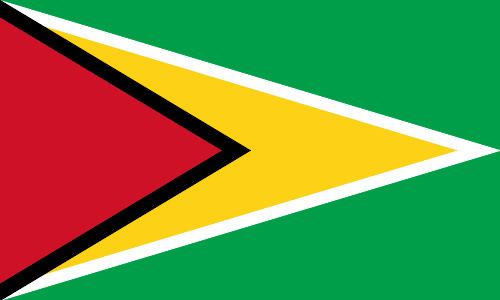Population 799,613 (2013) GNI per capita 6,610 PPP dollars (2013) Official language English | Life expectancy 66.05 years (2012) Population growth rate 0.5% annual change (2013) | |
 | ||
Fertility rate 2.59 births per woman (2012) | ||
This article is about the demographic features of Guyana, including population density, ethnicity, education level, health of the populace, economic status, religious affiliations and other aspects of the population.
Contents
- Map of Guyana
- Population
- Structure of the population
- Age structure
- Vital statistics
- Fertility and Births
- Ethnic groups
- Language
- Second and third languages
- References
Map of Guyana
Guyana's population (Guyanese people) is made up of six main ethnic groups: Amerindians, Africans, Indians, Europeans, Portuguese and Chinese. Ninety percent of the inhabitants live on the narrow coastal plain, where population density is more than 115 inhabitants per square kilometre (300/sq mi). The population density for Guyana as a whole is low: less than four inhabitants per square kilometre (10.4/sq mi).
Although the government has provided free education from nursery school to the university level since 1975, it has not allocated sufficient funds to maintain the standards of what had been considered the best educational system in the region. Many school buildings are in poor condition, there is a shortage of text and exercise books, the number of teachers has declined, and fees are being charged at the university level for some courses of study for the first time.
Guyana continues to be influenced by British culture as well distantly with the cultures of the United States, Europe, Africa, the Islamic world, East and South Asian countries, and Latin America, esp. with neighboring countries of Venezuela and Brazil. It is one of three countries and two territories to form The Guianas, such as Suriname and the island of Trinidad and Tobago; and territories like the French Guiana and parts of neighboring countries named for Guayana (Venezuela) and Amapa of Brazil.
Population
According to the 2015 revision of the CIA World Factbook, the total population was 735,222 in 2016. The proportion of children below the age of 15 in 2010 was 33.6%, 62.1% was between 15 and 65 years of age, while 4.3% was 65 years or older.
Structure of the population
Structure of the population (01.07.2010) (Estimates – unrevised data)
Age structure
0–14 years: 35.6% (male 135,629; female 131,518; total 267,147)
15–64 years: 60.2% (male 226,058; female 226,551; total 452,609)
65 years and over: 4.2% (male 14,347; female 17,120; total 31,467) (2002 census)
Vital statistics
The Population Departement of the United Nations prepared the following estimates of vital statistics of Guyana.
Fertility and Births
Total Fertility Rate (TFR) (Wanted Fertility Rate) and Crude Birth Rate (CBR):
Ethnic groups
The present population of Guyana is racially and ethnically heterogeneous, with ethnic groups originating from India, Africa, Europe, and China, as well as indigenous or aboriginal peoples.
The largest ethnic group is the Indo-Guyanese (also known as East Indians), the descendants of indentured labourers from India, who make up 43.5% of the population, according to the 2002 census. They are followed by the Afro-Guyanese, the descendants of slaves from Africa, who constitute 30.2%. Guyanese of mixed heritage make up 16.7%, while the indigenous peoples (known locally as Amerindians) make up 9.1%. The indigenous groups include the Arawaks, the Wai Wai, the Caribs, the Akawaio, the Arecuna, the Patamona, the Wapixana, the Macushi and the Warao. The two largest groups, the Indo-Guyanese and Afro-Guyanese, have experienced some racial tension.
Most Indo-Guyanese are descended from Bhojpuri-speaking Bihari and Uttar Pradesh migrants. Many Indo-Guyanese are also Tamil speaking Tamils from Tamil Nadu, and Telugus of Andhra Pradesh in South India.
The distribution pattern in the 2002 census was similar to those of the 1980 and 1991 censuses, but the share of the two main groups has declined. Indo-Guyanese made up 51.9% of the total population in 1980, but by 1991 this had fallen to 48.6%, and then to 43.5% in the 2002 census. Those of African descent increased slightly from 30.8% to 32.3% during the first period (1980 and 1991) before falling to 30.2% in the 2002 census. With small growth in the overall population, the decline in the shares of the two larger groups has resulted in the relative increase of shares of the multiracial and Amerindian groups. The Amerindian population rose by 22,097 people between 1991 and 2002. This represents an increase of 47.3% or annual growth of 3.5%. Similarly, the multiracial population increased by 37,788 persons, representing a 43.0% increase or annual growth rate of 3.2% from the base period of 1991 census. The number of Portuguese, Chinese and White population is about 0.5%
Language
English is the official language of Guyana, which is the only South American country with English as the official language.
Guyanese Creole (an English-based creole with African and/or East Indian syntax) is widely spoken in Guyana.
A number of Amerindian languages are also spoken by a minority of the population. These include Cariban languages such as Macushi, Akawaio and Wai-Wai; Arawakan languages such as Arawak (or Lokono) and Wapishana.
Other languages spoken include Chinese, Hindi and Tamil .
Second and third languages
Portuguese is an increasingly widely used as a second language in Guyana, particularly in the south of the country, bordering on Brazil. Dutch and French are spoken by those who frequently visit neighboring French Guiana and Suriname. French is widely taught in secondary schools along with Spanish as foreign languages. Spanish is also used by a minority of the population as a second language. Spanish is spoken typically by visitors and residents from Venezuela.
